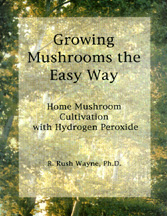

The first volume of the peroxide manual introduced a whole new approach to home mushroom cultivation, one that has gained a reputation for its ease and simplicity. The manual showed how mushrooms could be grown readily without sterile facilities, air filtration, or autoclaves. Now, for growers interested in commercial cultivation, and hobby growers too...
Prepare any quantity of bulk substrate at room temperature.
The second volume of the peroxide manual adds two ground-breaking peroxide methods that can be used to prepare as much substrate as you need without the trouble of heating and cooling.
Just soak your substrate, drain, and inoculate.
The first method is a simple soak-and-drain procedure designed for use with materials such as straw, bagasse, dried grasses, corn stalks, cottonseed hulls, etc. You just load the substrate into a soak chamber, fill it with the appropriate solution at room temperature, soak until the proper moisture content is reached, then drain and inoculate. There's no caustic waste to worry about, no hassle with heating water or steam, and no concern about peroxide-decomposing enzymes in the substrate materials.
Add water and stir.
The other method is an add-and-stir procedure designed for use with peroxide-compatible porous substrates like wood pellet fuel, paper fiber pellets, or (for oyster mushrooms) kiln-dried sawdust . You simply mix all your ingredients together at room temperature, then come back in a couple of hours and inoculate. There's no hurry, though--peroxide keeps the substrate from spoiling. (Refer to Volume I for important information on choosing peroxide-compatible substrates and supplements).
Here's what else you'll find in Volume II:
Continue on down the page to read the Table of Contents for Volume II. This volume has 23 pages.
The drawbacks of Petri dish culture
Advantages and disadvantages of slants
Making peroxide slants
Making transfers to and from slants
Cleaning the mycelium with slants
Starting with Spores
Advantages and disadvantages of spore culture
Peroxide and spores revisited
Collecting spores
Germinating spores by the disk method
Why find a substitute for agar?
How to prepare the plates
Making transfers
Cleaning the mycelium
Storage cultures without agar
Sending cultures in the mail
Spawn Preparation
Spawn in plastic bags -- "Eight Minute Spawn"
Advantages and disadvantages of plastic bags
Making the spawn
Using the spawn
Inoculating straw without spawn
How to prepare the inoculum
Notes on the protocol
The issue of senesence
Preparing straw with peroxide at room temperature
Advantages of peroxide preparation of straw
What about the enzymes?
Protocol for preparing straw or other drainable substrates
Notes on the protocol
An "add-an-stir" method of preparing peroxide-compatible substrates
Advantages of the "Add-and-Stir" method
The protocol applied to wood pellet fuel at room temperature
Notes on the protocol
Natural nitrogen supplements for use with the protocol
How much water to add
How much peroxide to use
Making spawn by by the "add-and-stir" method